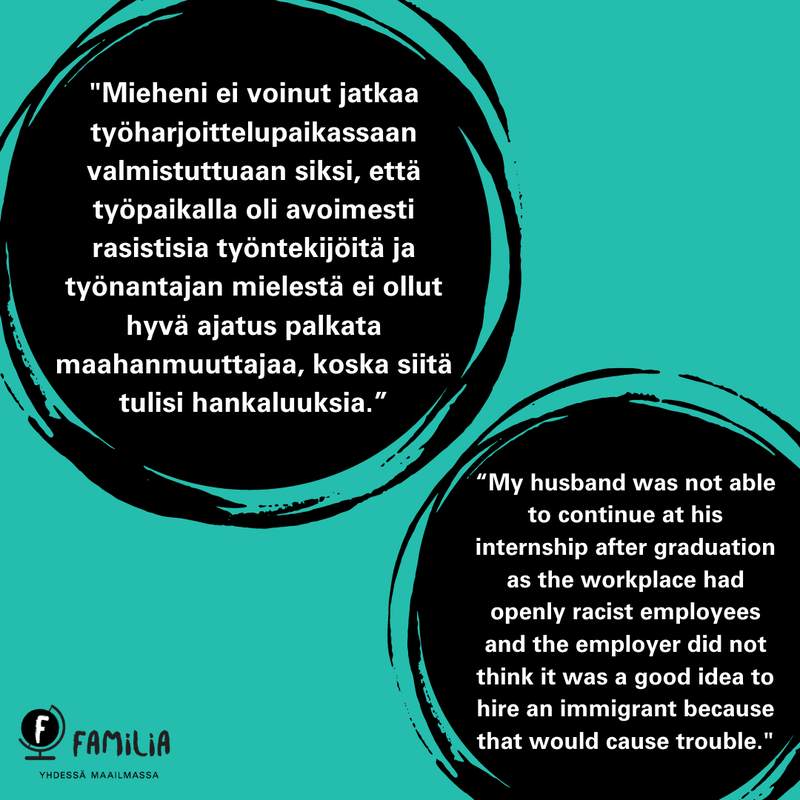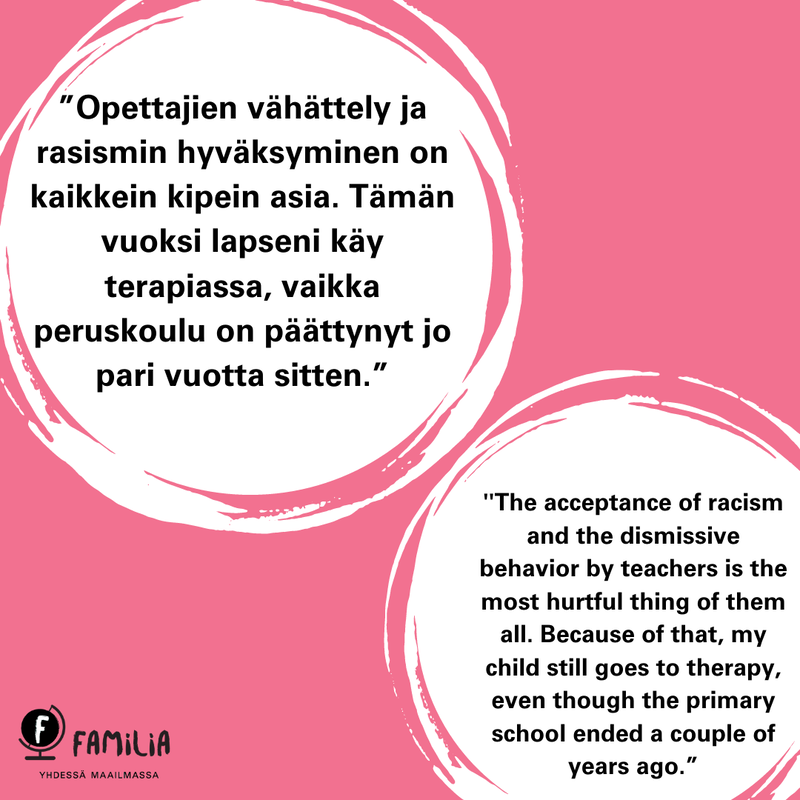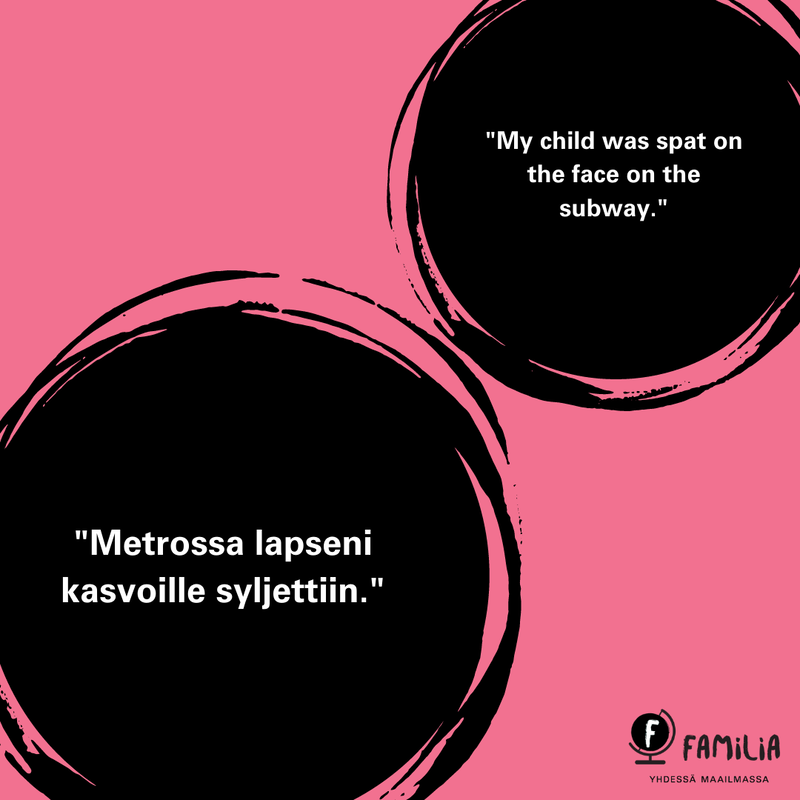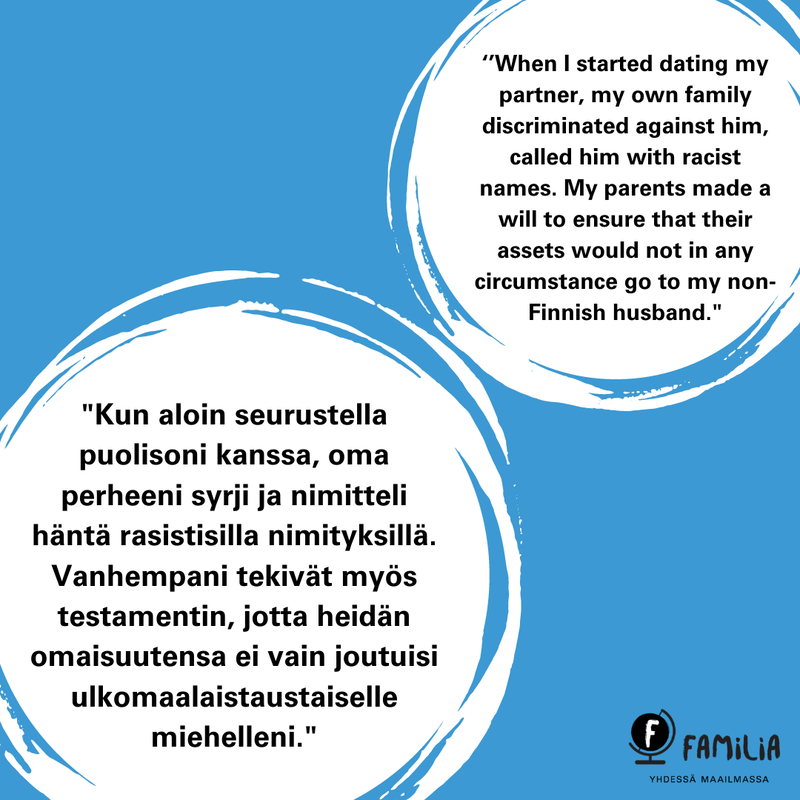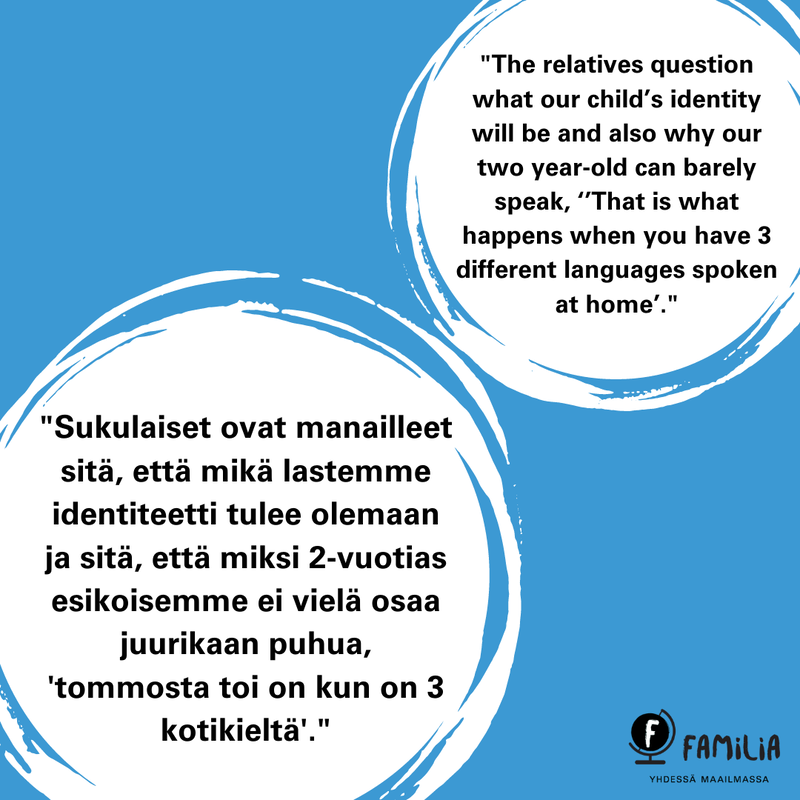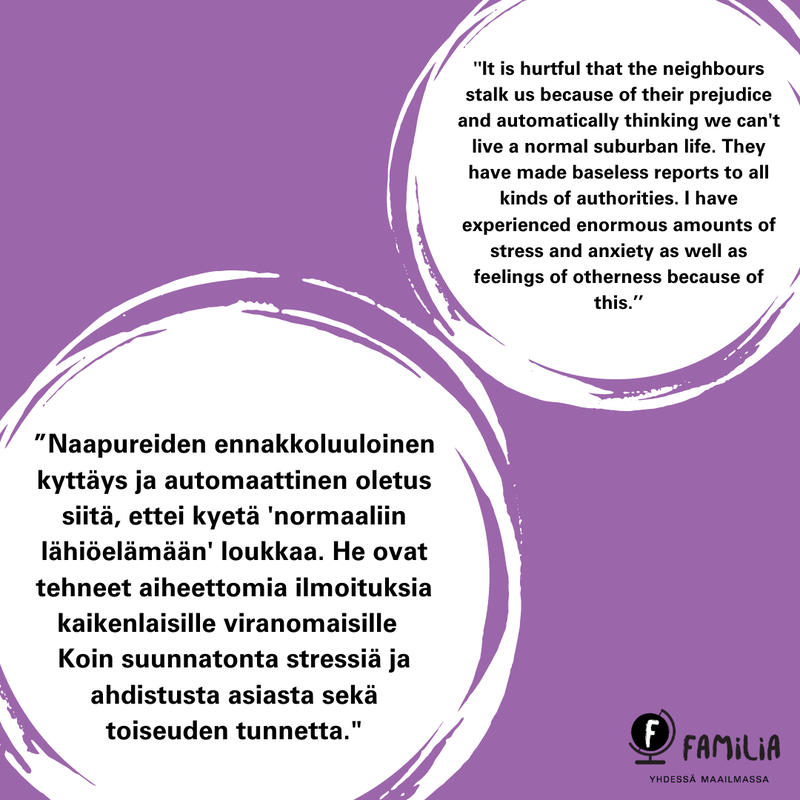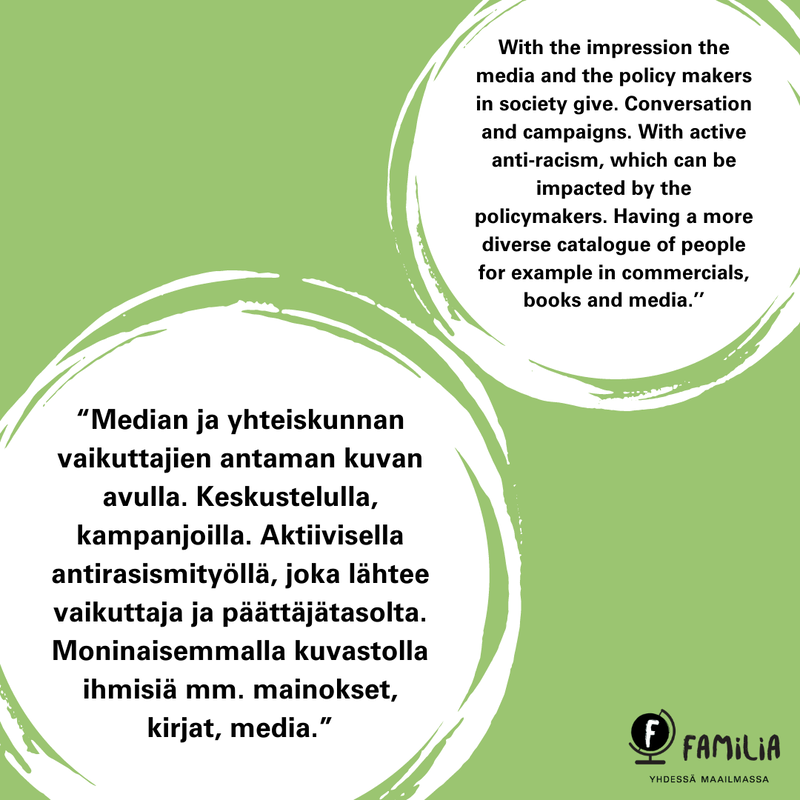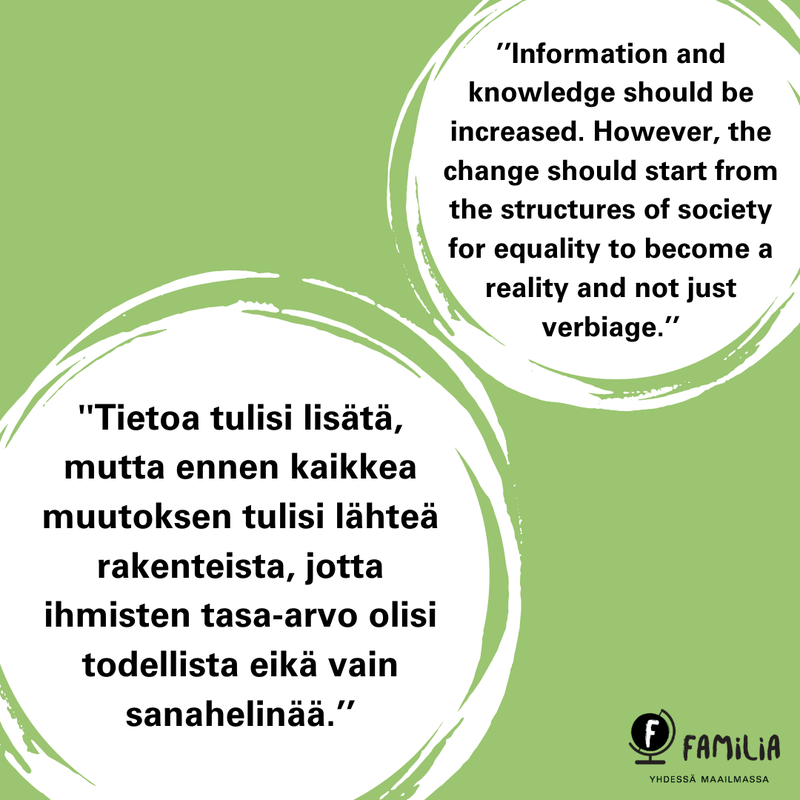|
The main focus of Familia is to increase the well-being and quality of life of intercultural couples and families in Finland. Familia shares information on the unique features of intercultural families and their needs in society and supports and develops the structures of an equal, multicultural Finnish society. Familia is an advocate of intercultural families and aims to impact the decision-making processes related to them.
|
|
Surveys
Racism and discrimination experienced by intercultural couples and families in FinlandDuring autumn 2020, Familia conducted a survey on racism and discrimination experienced by bi-cultural couples and families in Finland. A bicultural family is a family where the spouses come from different countries and have different cultural backgrounds. Familia is the only organisation in Finland that organises activities for bi-cultural families, provides specialised expertise and acts as an advocate for families. For Familia, the well-being of spouses and families is the basis of its activities and therefore we felt it was important to map experiences of racism and discrimination.
We wanted to use the survey to find out the experiences and perspectives of all parties in the family - both the immigrant, the Finnish spouse and the child. It is important to know about both good and bad experiences so that we can better advocate for our target group in society. We wanted to find out how we in Familia could do even better to prevent racism and discrimination. The aim was to gather information that we could use, for example, to develop our activities and to plan training courses for professionals in this field. We received answers from 147 people across Finland. Thirty percent of the intercultural families who replied to the survey had experienced racism aimed at their family monthly, and fifteen percent experienced the same daily. You can read the report of the study here (in Finnish). |
PUBLICATION CAMPAIGN OF "RACISM AND DISCRIMINATION EXPERIENCED BY INTERCULTURAL COUPLES AND FAMILIES" SURVEY results
Based on the survey, in Fabruary of 2021 we executed a social media campaign in which we published the results. The visual materials of the campaign can be found below, categorised by themes that arose from the data.
Employment
Ninety percent of the respondents of the Familia’s “Racism and discrimination experienced by intercultural couples and families in Finland” questionnaire stated that they had experienced discrimination or racism at their workplace or educational institute.
Many of the participants related their experiences of racism and discrimination to seeking employment. Most found it challenging to get a call to an interview even when they had been qualified for the job. Many had concluded that it was because of their name that was not Finnish. The employers had said directly that ‘’the workplace is not ready to hire a foreigner’’ or that ‘’immigrants are not wanted’’ because ‘’they do not understand or know the Finnish language’’. In some cases, the employer did not want to hire a foreigner because it would cause trouble with other, openly racist employees.
Many of the participants related their experiences of racism and discrimination to seeking employment. Most found it challenging to get a call to an interview even when they had been qualified for the job. Many had concluded that it was because of their name that was not Finnish. The employers had said directly that ‘’the workplace is not ready to hire a foreigner’’ or that ‘’immigrants are not wanted’’ because ‘’they do not understand or know the Finnish language’’. In some cases, the employer did not want to hire a foreigner because it would cause trouble with other, openly racist employees.
Public services
Out of all the participants who participated in the “Racism and discrimination experienced by intercultural couples and families in Finland”, 45 percent reported that they had faced racism and discrimination in governmental services such as healthcare services, TE services, or KELA services.
The respondents reported the consulting regarding immigration received from the public sector as problematic. They viewed the inadequate amount of received consulting and counselling and receiving the decisions only in Finnish as an issue of structural discrimination. Some of the participants also had experiences of racist and discriminatory behaviour with individuals working in social or healthcare services.
In the questionnaire responses, the Finnish partners recalled that their partners had not been treated equally compared to them at public services. They felt that the Finnish partners had been seen as interpreters, or the consulting at governmental services had only been given to them, which meant that the responsibility of translating and providing the correct information to their partner had fallen on them.
The problems mentioned above were reoccurring, especially in healthcare services, TE services, and KELA. The accessibility of healthcare services was also more difficult for people who did not speak Finnish. Some of the people who answered the questionnaire recalled that as a foreigner, one has to be highly active and know about things in advance to access governmental services. In the responses, the statement that ‘’customer service workers expect one to know what they are entitled to. Otherwise, they do not inform them’’ was reoccurring.
The respondents reported the consulting regarding immigration received from the public sector as problematic. They viewed the inadequate amount of received consulting and counselling and receiving the decisions only in Finnish as an issue of structural discrimination. Some of the participants also had experiences of racist and discriminatory behaviour with individuals working in social or healthcare services.
In the questionnaire responses, the Finnish partners recalled that their partners had not been treated equally compared to them at public services. They felt that the Finnish partners had been seen as interpreters, or the consulting at governmental services had only been given to them, which meant that the responsibility of translating and providing the correct information to their partner had fallen on them.
The problems mentioned above were reoccurring, especially in healthcare services, TE services, and KELA. The accessibility of healthcare services was also more difficult for people who did not speak Finnish. Some of the people who answered the questionnaire recalled that as a foreigner, one has to be highly active and know about things in advance to access governmental services. In the responses, the statement that ‘’customer service workers expect one to know what they are entitled to. Otherwise, they do not inform them’’ was reoccurring.
School and Day care
Out of all the participants who took part in the "Experiences of racism and discrimination that intercultural families have faced in Finland" questionnaire," 40 percent recalled that their child had faced racism or discrimination at kindergarten or school. The respondents highlighted cases of bullying by other pupils, social excluding and stereotypes. Bullying because of a child's appearance was also common. Other parents had also been racist and discriminatory by forbidding their children of playing with the participants' children.
In addition, several participants recalled that their child had also faced racist and discriminatory behaviour from the faculty. The school had refused to intervene in the racist and excluding behaviour the faculty were subjecting their children to. The participants also mentioned that the faculty lacked know-how and experience in removing racism and discrimination in schools and kindergartens.
The parents who took part in the questionnaire described the discrimination and racism their child had faced as heartbreaking, unequal, painful, stressful, and offensive. The experiences awoke feelings of anger, sadness, bitterness, helplessness, rage, and fear in the parents. One of the participants described the racism and discrimination aimed at their child in the following way: "the most horrible feeling in the world: the powerlessness and frustration are paralysing." Another participant stated that the racism and discrimination their child has faced has been "the most painful feeling me as a parent has had to face."
In addition, several participants recalled that their child had also faced racist and discriminatory behaviour from the faculty. The school had refused to intervene in the racist and excluding behaviour the faculty were subjecting their children to. The participants also mentioned that the faculty lacked know-how and experience in removing racism and discrimination in schools and kindergartens.
The parents who took part in the questionnaire described the discrimination and racism their child had faced as heartbreaking, unequal, painful, stressful, and offensive. The experiences awoke feelings of anger, sadness, bitterness, helplessness, rage, and fear in the parents. One of the participants described the racism and discrimination aimed at their child in the following way: "the most horrible feeling in the world: the powerlessness and frustration are paralysing." Another participant stated that the racism and discrimination their child has faced has been "the most painful feeling me as a parent has had to face."
Public spaces
Based on the answers of the people who took part in the questionnaire, the most common experiences of racism and discrimination were caused by strangers. As much as 90 percent of the spouses who had moved to Finland reported facing racist and discriminatory behaviour by strangers.
The most common place where the participants had been subject to racist and discriminatory acts was in public, such as parks, the street, and public transportation. The racist and discriminatory behaviour was often carried out as name-calling, heckling, belittling, and inappropriate comments. Ninety percent of the participants had had to face this kind of behaviour.
The participants felt that in addition to the direct racist comments, the non-verbal acts such as angry looks, which 85 percent had had to experience. One of the participants stated that other people were not reacting and defending them against the racist remarks and pretended they did not hear or see the situation was even more painful than the actual racist or discriminatory act. This experience was brought up by several other participants, too. Many stated that because of their experiences of racist and discriminatory behaviour, they or their children now avoid using their native language in public.
The most common place where the participants had been subject to racist and discriminatory acts was in public, such as parks, the street, and public transportation. The racist and discriminatory behaviour was often carried out as name-calling, heckling, belittling, and inappropriate comments. Ninety percent of the participants had had to face this kind of behaviour.
The participants felt that in addition to the direct racist comments, the non-verbal acts such as angry looks, which 85 percent had had to experience. One of the participants stated that other people were not reacting and defending them against the racist remarks and pretended they did not hear or see the situation was even more painful than the actual racist or discriminatory act. This experience was brought up by several other participants, too. Many stated that because of their experiences of racist and discriminatory behaviour, they or their children now avoid using their native language in public.
Authorities
The participants of questionnaire stated that they had faced racist and discriminatory behaviour from the police and other authorities such as customs officers, security guards, and ticket inspectors. Some felt that these authorities had stopped them or their family member simply because of their external appearance. However, the inspections have been justified as random. The Finnish spouses who took part in the questionnaire stated that they had never faced the same inspection by the authorities, such as the police without reason, unlike their black spouses. According to the participants, the inspections were persistent at harbors and airports.
One of the participants recalled that the treatment with the authorities mentioned above was often a lot harsher and stricter towards foreigners and people with a foreign background. Many participants stated that security guards had repeatedly followed their spouse who had a foreign background at the grocery store. Multiple participants also said that their foreign partners' tickets validity had been questioned numerous times by the ticket inspectors without proper reason.
One of the participants recalled that the treatment with the authorities mentioned above was often a lot harsher and stricter towards foreigners and people with a foreign background. Many participants stated that security guards had repeatedly followed their spouse who had a foreign background at the grocery store. Multiple participants also said that their foreign partners' tickets validity had been questioned numerous times by the ticket inspectors without proper reason.
Family members and relatives
Fifty percent of the participants had experienced racism or discrimination either personally or as a family while socialising with their partner's relatives. Most of them said that this took place a few times a year. Yet, on average, 4 percent said that racist and discriminatory behaviour from relatives occurred as often as monthly or even weekly. Approximately fifty percent said that they hadn't encountered racism or discrimination from the side of relatives at all.
The respondents said that there had been prejudice from relatives' side, especially if the non-Finnish partner presented a different ethnicity or religion than the relatives themselves did. The respondents reported that the relatives had called their partners racist names and criticised their partner's home country or culture while the partner was present. Some relatives had expressed that they did not believe that a man from another culture would be capable of gender-equal parenthood. Some had corrected the grammar of the non-Finnish partner. Some had openly criticised the fact that the partner preferred English, as "if in Finland, you should be able to speak Finnish." One respondent said that their family members had directly asked them whether "you really married out of love or did you just want to save a refugee," or they had been told that "I guess soon you will be wearing one of those burka things."
The respondents said that there had been prejudice from relatives' side, especially if the non-Finnish partner presented a different ethnicity or religion than the relatives themselves did. The respondents reported that the relatives had called their partners racist names and criticised their partner's home country or culture while the partner was present. Some relatives had expressed that they did not believe that a man from another culture would be capable of gender-equal parenthood. Some had corrected the grammar of the non-Finnish partner. Some had openly criticised the fact that the partner preferred English, as "if in Finland, you should be able to speak Finnish." One respondent said that their family members had directly asked them whether "you really married out of love or did you just want to save a refugee," or they had been told that "I guess soon you will be wearing one of those burka things."
Neighbours
The respondents also repeated racist and discriminatory behaviour from neighbours. Many said the neighbours tried to "get them out of the building" because of their language, culture, or religion.
How to Influence prejudice
Ninety-three percent of the respondents believed that we could impact other people's prejudice and attitudes. Below you will find some ideas on how we could achieve that change.
The respondents believed that we could impact prejudice and attitudes through the early childhood education, primary school, and other education. The anti-racist upbringing was seen as vital. In addition, the respondents recognised the role of media and media representations, social media, advertising, and political decision-making. For the respondents, influencing the societal structures was important in decreasing racism and discrimination. They also mentioned harsher sentences, discussion, and communication.
Anti-rasism project: TOOLS FOR SPEAKING ABOUT RACISM AND DISCRIMINATION for families and professionals
FUNDER OF THE PROJECT: MINISTRY OF JUSTICE
|
BACKGROUND OF THE PROJECT
Kahden kulttuurin perheitä on Suomessa noin 80 000, joista noin puolet ovat lapsiperheitä. Suomessa on noin 3000 alle 18-vuotiasta kansainvälisesti adoptoitua lasta (ja suurin piirtein saman verran perheitä). Familia toteutti kesällä 2020 kyselyn, jonka aiheena oli kahden kulttuurin perheiden kokema rasismi ja syrjintä Suomessa.
Kyselyssä esille noussutta
|
|
MISTÄ ANTIRASISMIHANKKEESSA ON KYSYMYS?
Antirasismihankkeessa luodaan työkaluja rasismin ja syrjinnän kokemusten käsittelyyn kahden kulttuurin perheissä ja adoptioperheissä. Idean pohjalta kehitettiin kolmen palikan malli, joka käsittää seuraavat osiot: VIRTUAALINEN OPAS
Kolmen palikan mallin käyttö
Tiedotamme hankkeen etenemisestä kevään aikana. Eli kannattaa seurata Familian somea ja nettisivuja. |



